In spite of the recent close-downs in the UK high street and companies over 200 years old such as Debenhams are going bankrupt, the internet sales have been growing consistently year after year since 2006.
Most relevant online shopping statistics
- E-commerce sales in the United Kingdom hit 586 billion pounds in 2017.
- As of June 2019, internet sales represent almost 20% of all the total retail sales.
- Ecommerce retail sales will grow 10.9% this year, to reach £106.46 billion ($141.93 billion) and 22.3% of total retail.
- In the United Kingdom, e-commerce B2B sales were 133 billion pounds.
- Growth in retail spend is being affected by Brexit concerns but so far this year 2019, total retail sales will reach £476.65 billion ($635.46 billion).
- The top three e-commerce industries in the United Kingdom are clothes (including sporting goods), household goods and holiday accommodations by that order.
- In 13 years e-commerce has grown about 15% (from 3% in 2006 to 18% in 2019 of total retail sales). See below what the actual growth year by year.
- As of 2015 in the United Kingdom, the value of the average desktop sales was almost 67 pounds and £53.92 for mobile devices.
- 82% of people in the United Kingdom made purchases online.
- After all, almost eight in 10 retail pounds spent are in physical stores.
- The average conversion rate in desktop devices is 3.6% and 1.3% for mobile phones. Whilst in-store conversion rate is 22%.
- Online non-food sales 21%. Online fashion- sales 24%.
- E-commerce sales in the United Kingdom didn’t grow for 3 consecutive years from 2014-2016.
- Analysts forecast that fashion e-commerce revenue in the United Kingdom will be worth 18.6 billion pounds in 2020
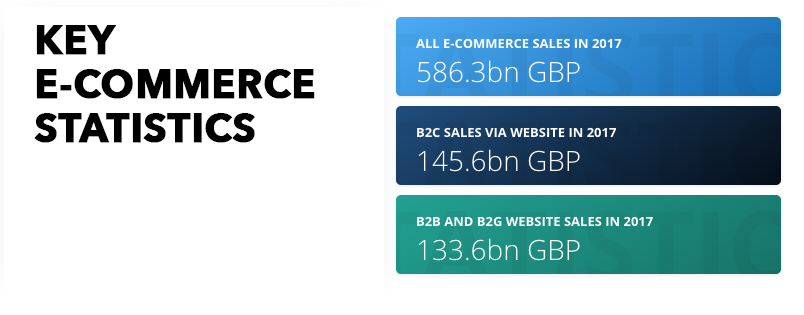
How much do online sales account for all the total retail sales?
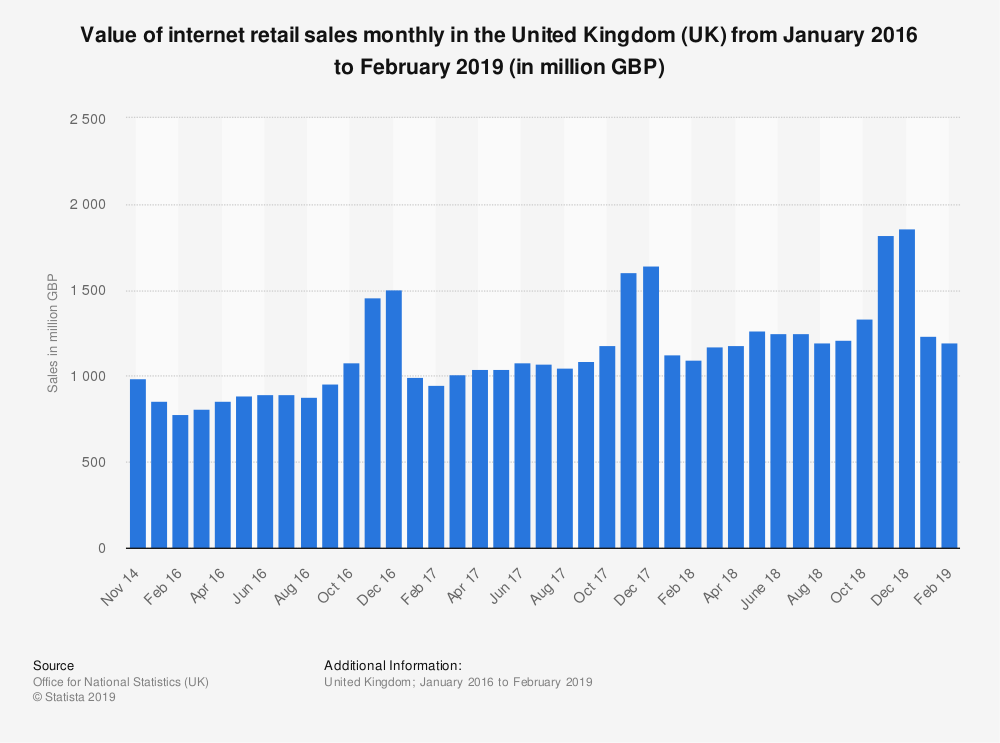
In spite of the recent close-downs in the UK high street and companies over 200 years old such as Debenhams are going bankrupt, internet sales have been growing consistently year after year since 2006.
As of 2019, the total online e-commerce industry accounts for around 19% of total retail sales, and it comes up to over 1200 million pounds.
E-commerce sales in the United Kingdom hit 586 billion pounds
Statistic – Fact
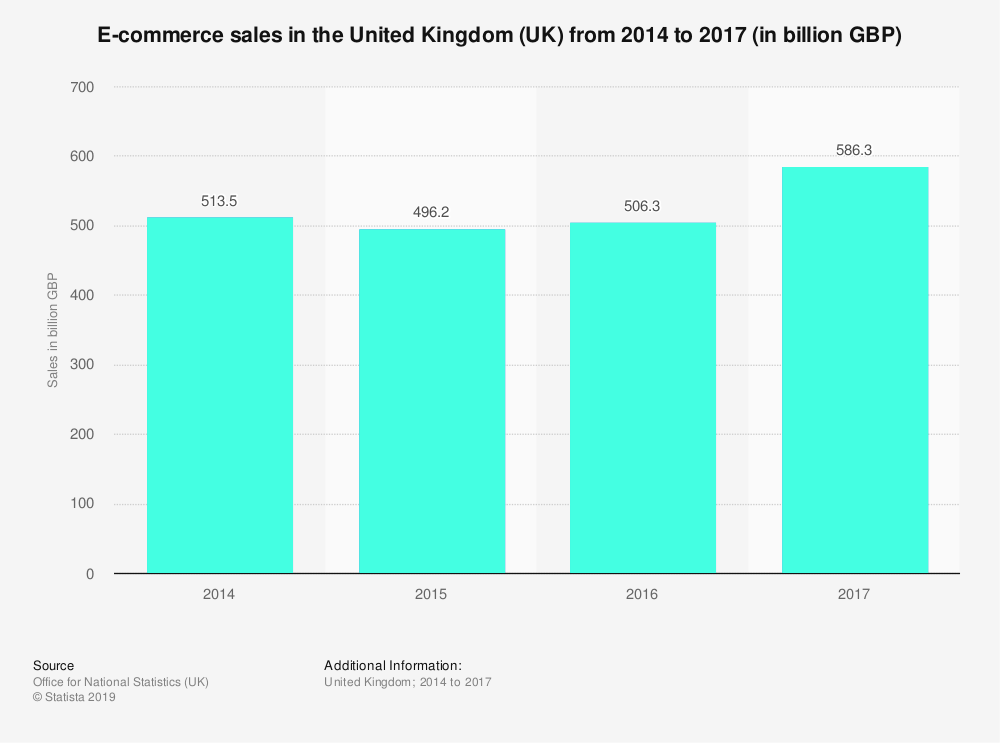
Taking it from decade to decade, e-commerce has grown exponentially. Even though the UK brick and mortar retail sector seems to be struggling, and most retail is decelerating, e-commerce continues to grow.
Growth in retail spend is being affected by Brexit concerns but so far this year 2019, total retail sales will reach £476.65 billion ($635.46 billion).
There are some industries which perform better than others, for example, beauty products have become very popular in the last few years and online retailers have contributed partly by offering a wider range of choices.
Other products such as second-hand items and holidays have benefited from the e-commerce characteristics: everywhere every time. The size of the e-commerce industry in February 2019 was over 1200 million pounds.
As of June 2019, internet sales represent almost 20% of all the total retail sales
Statistic – Fact
E-commerce keeps growing every year and currently represents almost 20% of all retail sales. Many predict the future of retail revolves around e-commerce and brick and mortar stores as we know them today will be something from the past.
That is the reason why many retailers are trying to keep their store sales up at its best performance by creating a complete new shopping experience therefore executives are investing more in experiential and participation marketing strategies to drive more attention and keep millennials engaged as this generation is more driven by experiences over material possessions. In fact, most customers expect some sort of experience when visiting a store.
E-learning materials, medicines and computer hardware remain at the bottom of this chart. It doesn’t necessarily mean that those three industries are not performing well online, it is just simply there are smaller markets.
The e-commerce sector has exploded in the past few years, the internet has shaped the way we shopped and technological giants have helped to create new consumers habits, even though analysts believe it will continue to grow over the course of the following years.
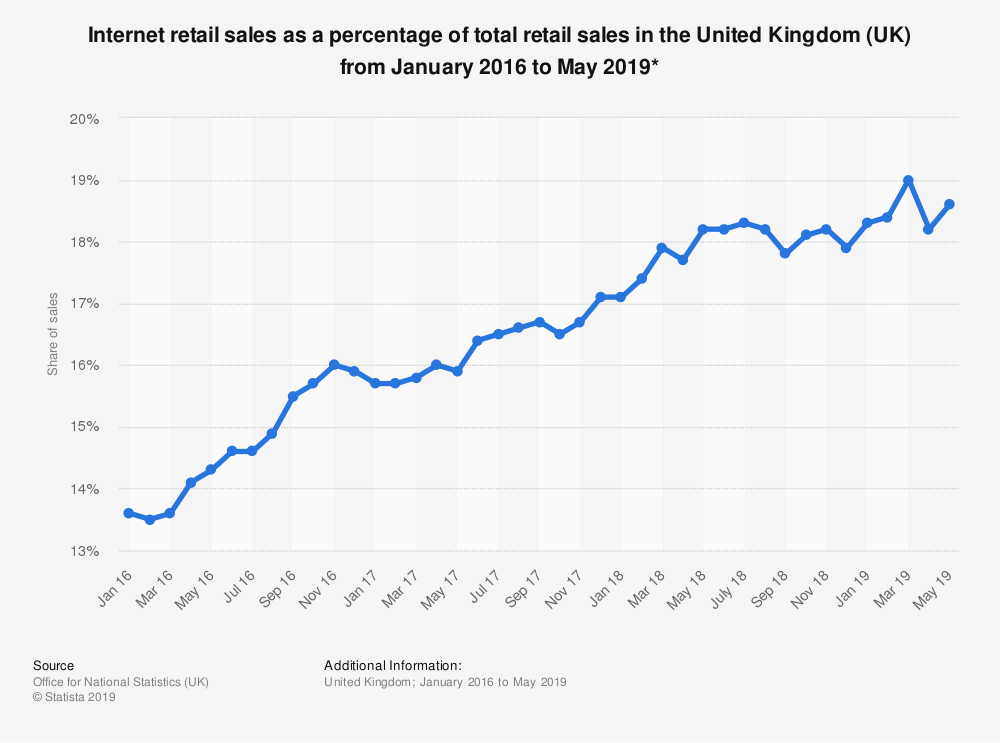
What is the largest e-commerce industry?
The top three e-commerce industries in the United Kingdom are clothes (including sporting goods), household goods and holiday accommodations respectively
Statistic – Fact
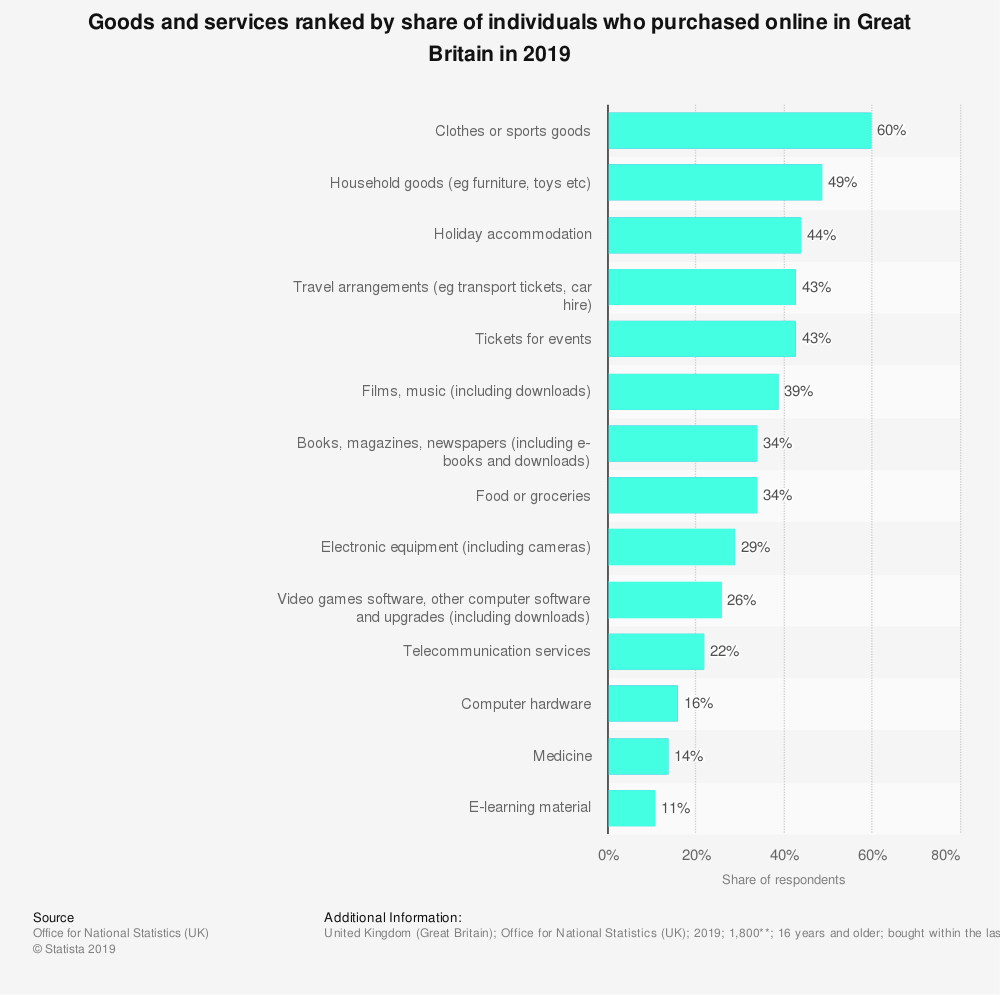
Unsurprisingly fashion and clothing is the largest e-commerce industry, household goods come second on the list followed by holidays.
At the bottom of the list, there are e-learning education and materials, computer hardware and medicine. Travel arrangements also take a wide share of the e-commerce market.
How much has e-commerce has grown in the last two decades?
In 13 years e-commerce has grown about 15%
Many wondered how much e-commerce has grown compared to total retail since the rise of the internet. In the chart below, you can see the continuous growth of the online shopping market.
As you can see from November 2006 when e-commerce barely represented 3% of total retail sales in the United Kingdom, it has grown around 800% up to almost 20% of the total. The yearly peaks you see over the years represent the Christmas period.
Even though it is not until 2013 July that online shopping did not account for 10% of total retail sales. It is predicted that the upward trend will continue for many more years.
After all, almost eight in 10 retail pounds spent are in physical stores
Statistic – Fact
Average online shopping order value
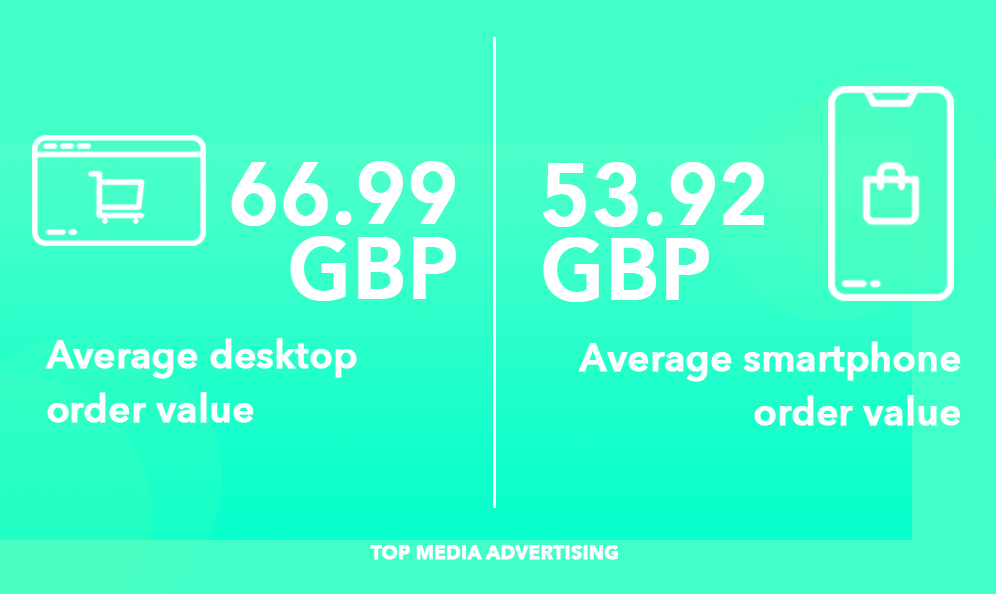
As of 2015 in the United Kingdom, the value of the average desktop sales was almost 67 pounds and £53.92 for mobile devices. If we compare that figure with the in-store counterpart, the AVT (average transaction value) of physical stores in the UK is 35.35 pounds as of 2019, which represents around 45% less than for an average transaction on a desktop device.
Needless to say that consumers are less likely to buy a sandwich online and much smaller transaction such as buying a coke from the shop is a typical in-store only transaction; this explains why in-store AVT is much lower than its online counterpart.
The penetration rate of e-commerce in the United Kingdom
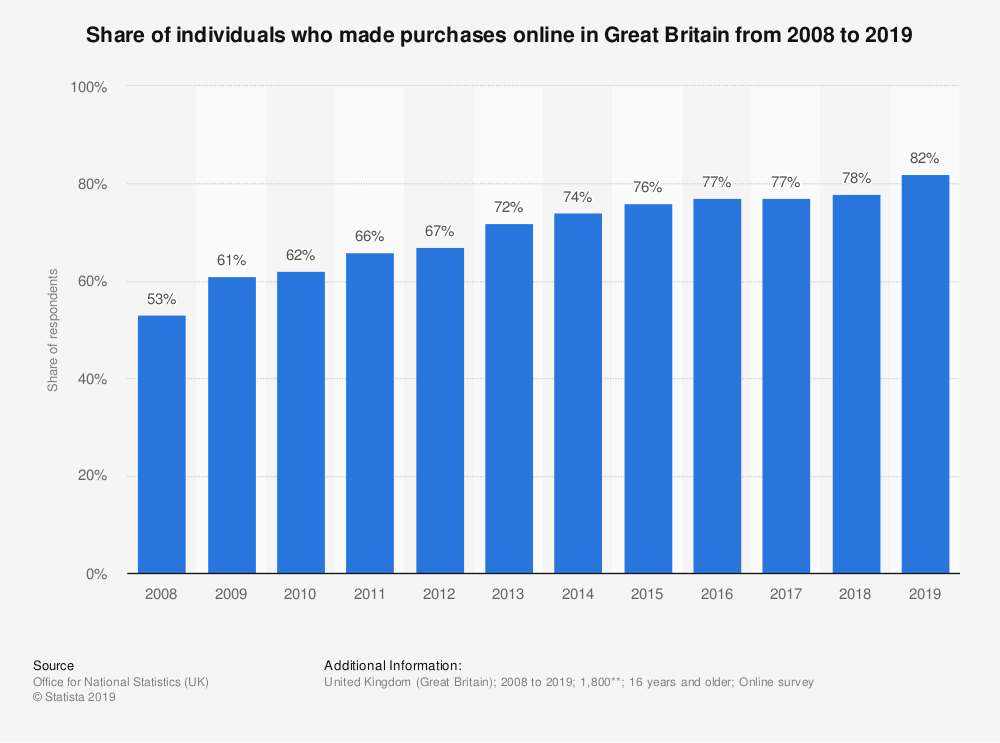
82% of people in the United Kingdom made purchases online
Statistic – Fact
To the surprise of many, not every single individual in the UK used e-commerce to purchase. As you can see in the chart above, in 2019 82% of the population made purchases online, almost 30% more users than ten years ago.
There has been a steady growth in the number of online shoppers each year which is predicted to continue growing. There is still a number of people who did not purchase online such as elderly people.
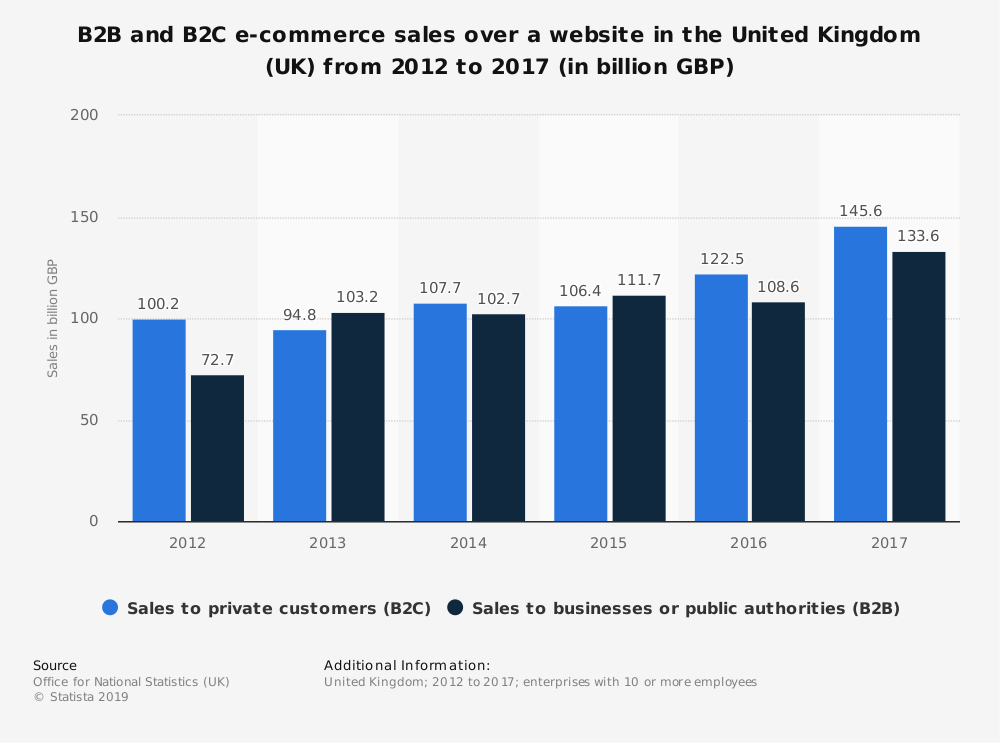
B2B e-commerce almost doubled in size in five years times while B2C also shows a great expansion in sales in the United Kingdom from 2012 to 2017.
Retail e-commerce business to consumers sales
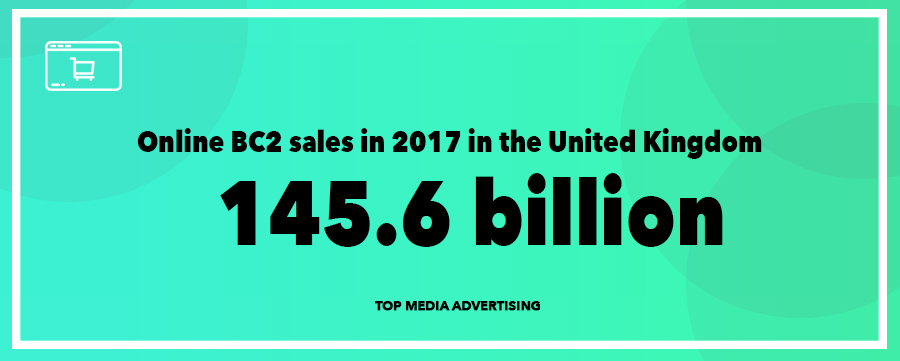
E-commerce percentage of the total retail sales in the United Kingdom compared to other EU countries

Compared to other countries, Britons buy more online than citizens from all the other European countries. For example in countries like Italy and Poland where e-commerce sales account for less than 5% of the total retail sales.
However, the pace of growth shows a similar pattern to the one in the UK. E-commerce keeps growing each year even almost every country for 5 consecutive years.
Average conversion rate in desktop devices is 3.6% and 1.3% for mobile phones but in store it is 22%
Statistic – Fact
When dealing with online shopping, conversion rate is a very important factor which could help retailers understand whether they are targeting the right audience and if their website is fully optimized to convert as many visitors as possible.
There are multiple factors which intervene to increase conversion rate but we can´t deal with them in this post. On the other hand, the in-store conversion rate is much higher as it stands at around 22.5%.
Online non-food sales 21%. Online fashion- sales 24%
Statistic – Fact
E-commerce sales in the United Kingdom didn’t grow for 3 consecutive years from 2014-2016
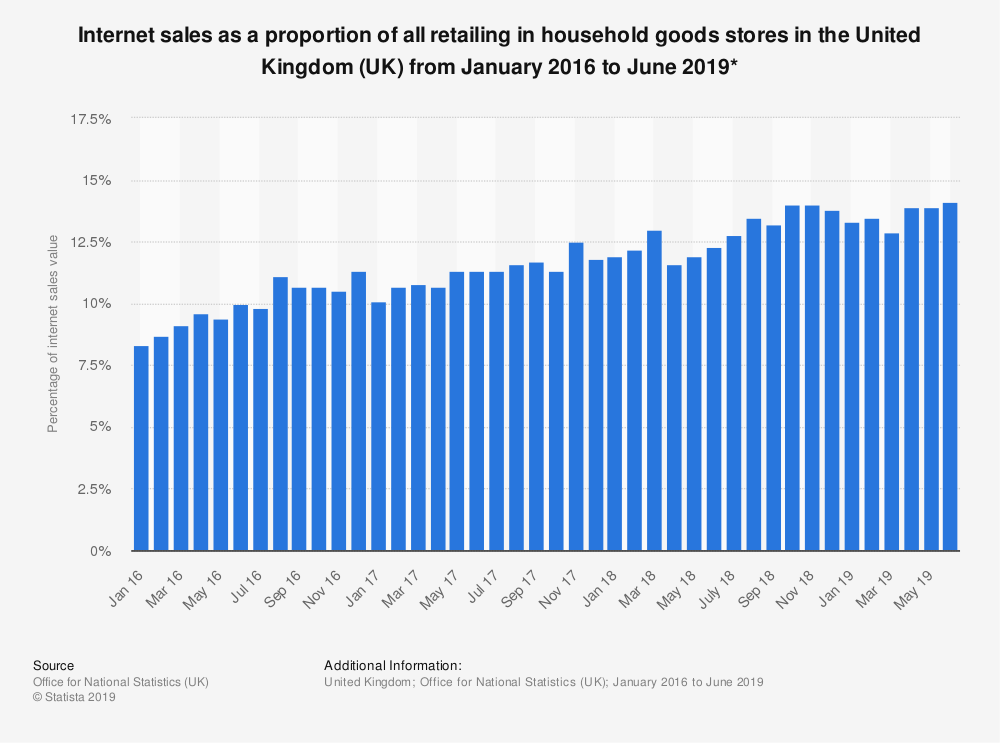
What is the growth of online shopping sales as of 2019? What is the future of e-commerce like?
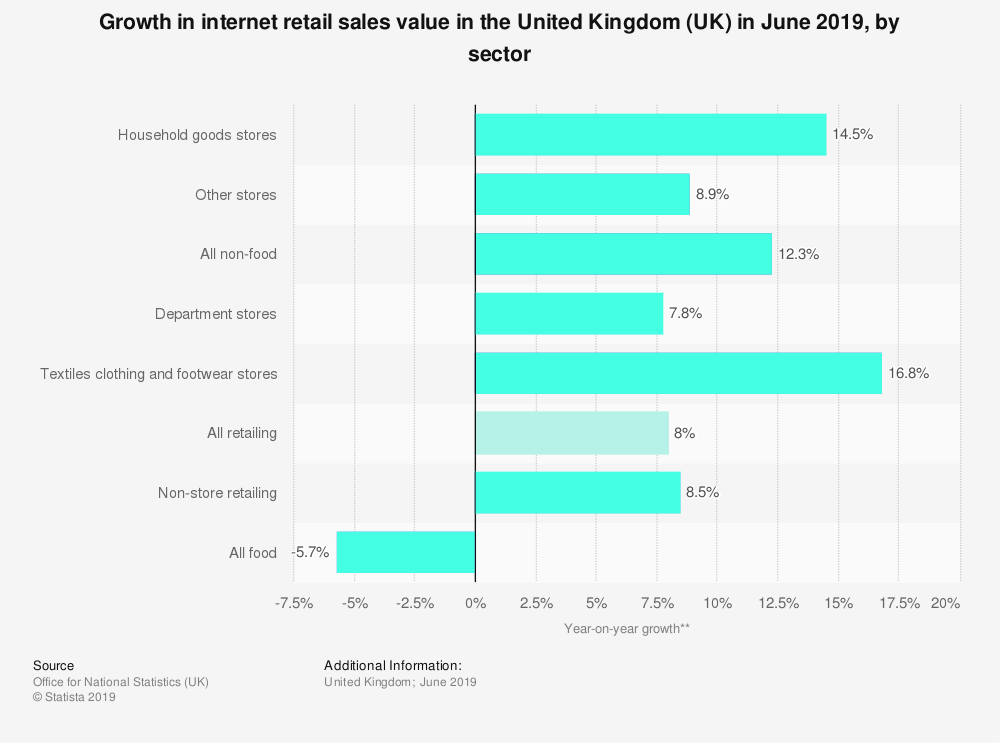
In spite of the bad news that has been hitting the UK high street, very sounded closedowns such as Karen Millen, Coast, HMV, and companies over 200 years old such as Debenhams announcing bankrupt along with the Arcadia Group, retail sales, in general, have been presenting very healthy numbers and steady growth over the last few years.
The chart below shows the number of new store openings in the United Kingdom. Needless to say that consumers habits have been influenced by e-commerce however there are positive figures and numbers which might not be sounded.
The growth in retail is obvious so what is it happening in the UK high street?
Experts believe this proves the High Street’s move away from traditional retailing. Even though supermarkets Aldi and Lidl are two of the big retailers that are still opening stores at a relatively fast pace.
In general, it looks like the UK high street has too many shops, they are too big and in the wrong locations.
People are buying products online more than ever before. Almost anything you would like can be purchased online and delivered to your door within a few days. E-commerce has grown massively over the last two decades and this upward trend will continue.
It is still too early to predict how much of the market will be online and how much of it will be like traditional retail. Some sectors could be exclusively online in the future while others might just remain as they are today.
It really depends on the market needs and consumers shopping habits. I personally believe that people will still enjoy visiting shops and shopping centres, therefore traditional retail will still continue in some form.
UK online shopping spend to grow 30% by 2024
Statistic – Fact
Consumers are now turning to online shopping as their preferred channel, and it is predicted to contribute to more than half (53%) of the total retail sales in the next ten years, according to a recent report commissioned by law firm Womble Bond Dickinson.
This month, it was reported that UK retail sales in July 2019 rose unexpectedly, with online spend contributing 19.9% of total retailing, compared with 18.9% in June 2019, according to the latest Retail Sales, Great Britain report by the Office for National Statistics (ONS).
ONS said that the increase in online spend shows an overall growth of 12.7% when compared with the same month a year earlier.
Sources:
- https://www.ons.gov.uk/businessindustryandtrade/itandinternetindustry/bulletins/ecommerceandictactivity/2017
- Statista
- diegopaz.net (Diseño de Paginas Web)
- https://www.retail-insight-network.com/features/uk-online-shopping-growth/
- https://www.vendhq.com/blog/retail-stats/





Like!! Thank you for publishing this awesome article.